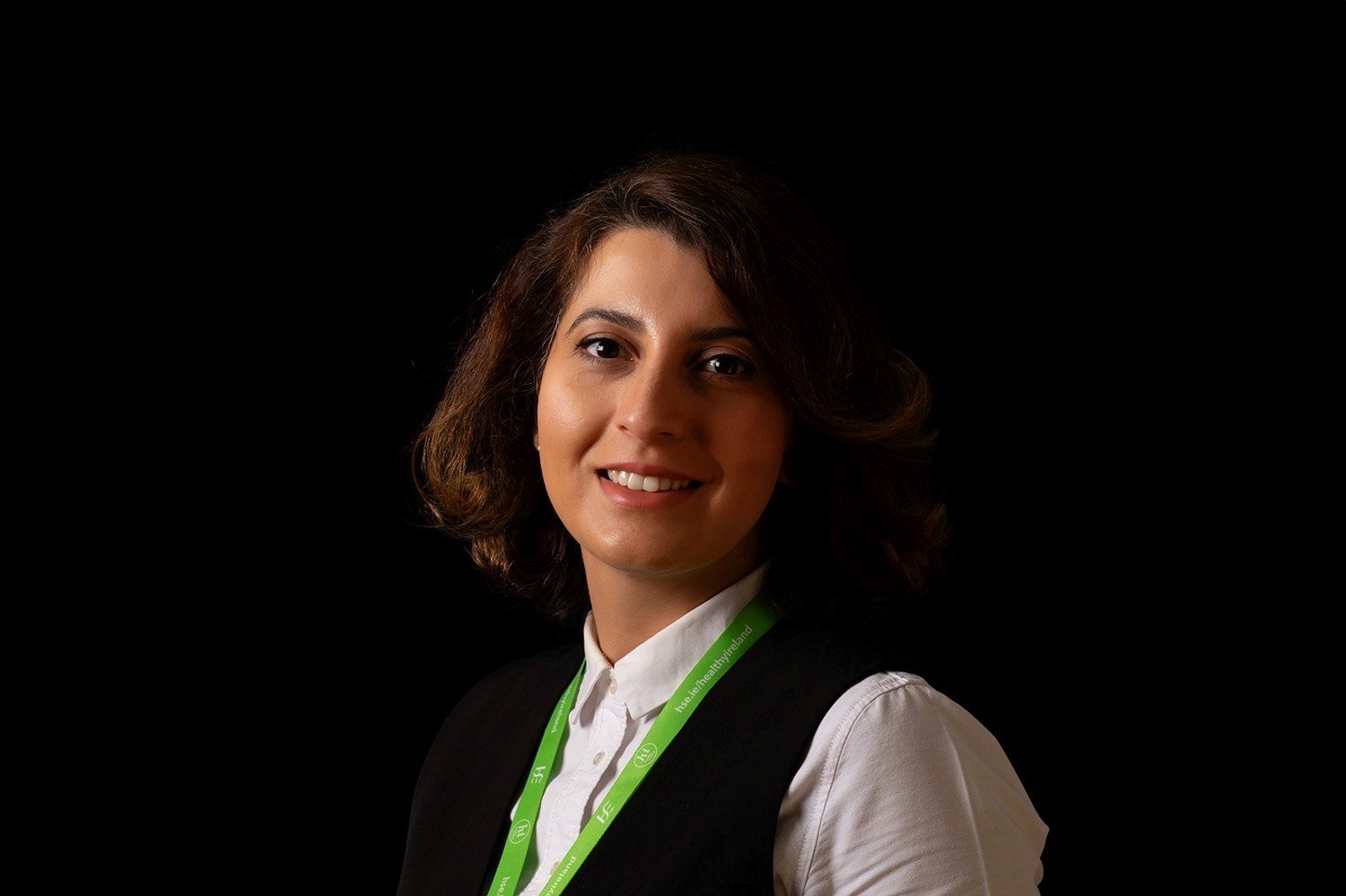Dr Mahnaz Sharafkhani: St James’s Research Profile
01/09/2023
At first glance, it may seem strange that a researcher who worked in an aerospace centre is now working in hospital care, but Dr Mahnaz Sharafkhani’s work demonstrates that there are very important connections between the two fields. The personal link for her is that she is “passionate about human well-being, safety and system performance.” While working in aerospace technology at the University of Nottingham, she was already focusing on health risks to passengers caused by long-haul flights such as Deep Vein Thrombosis.
She has recently joined St James’s Hospital as a member of Health Systems Research team, in the Quality and Safety Improvement Directorate (QSID), who were awarded funding from the HSE National Quality and Patient Safety Directorate to explore what would best practice in Human Factors Ergonomics (HFE) implementation look like in the Irish healthcare context. Talking to the Office of the Dean of Research, she discussed her current research, which focuses on improvements in patient safety and quality of care, efficiency, as well as staff and patient well-being.
Firstly, what is Human Factor Ergonomics? It may sound like a novel research field, she agrees, but it is involved in every aspect of our life such as physical, cognitive, cultural and social aspects. HFE aims to enhance both human well-being and overall system performance.
HFE is the scientific discipline concerned with the understanding of interactions among humans and other elements of a system, and the profession that applies theory, principles, data and methods to design in order to optimise human well-being and overall system performance (IEA, 2000). Healthcare HFE involves the application of multiple academic disciplines (e.g. engineering, psychology).
“If you want to design something, a medical device for example, there are human factors to consider. HFE should be involved in every stage of a design.” Working in the UK, she has experience collaborating with HFE researchers and practitioners and is now bringing that experience to Ireland.
When working as a Marie Curie Research Fellow in the University of Nottingham’s Institute for Aerospace Technology, she explored ways to improve aircraft passenger comfort especially during long-haul flights through the use of Virtual Reality Interventions. The aim, she explains, was to increase movements during the flight. Firstly, she conducted a study which established that passengers experience most discomfort in the neck and lower back. Following this, she conducted meetings with practitioners to see what movements were good for these discomfort areas. “Then based on the recommended movements, and having conducted several co-design and ideation workshops, I designed and prototyped an exertion game in Virtual Reality which is fun to play and encourages passengers to be more active during the flight, but it also increases their comfort.” The applicability of the interventions was explored through a somaesthetic-informed workshop. While working in TU Dublin she was involved in two further ergonomics projects based in manufacturing environments: one focused in machinery safety, the other using AI to improve physical ergonomics.
While HFE is now established in other sectors such as the field of transportation it is still in its infancy in healthcare. Medical practitioners are often concerned about human errors, but Sharafkhani believes these kinds of errors are a result of the system. So if we improve the system those errors can be reduced or even eliminated. This is why she wants to apply Human Factors at the system level in healthcare. Sharafkhani explains that the hospital environment interested her because there are many opportunities for HFE there: hospitals are such complex systems, much like those in aerospace technology. “Everything is so rapid, happening so quickly. Everyone is under time pressure. And it’s such an intense job.”
Sharafkhani has funding from the HSE National Quality and Patient Safety Directorate for a year’s research in St James’s Hospital. The first objectives of the project are to define best practice in HFE implementation and establish what is already being practised in Ireland; to develop a framework for measuring best practice in HFE implementation; and to develop recommendations for leaders on next steps in the advancement of HFE in the Irish health care system.
To demonstrate the elements of HFE she will focus on, she gives the example of the clinical handover between healthcare professionals. She plans to observe how it is currently executed and what aspects of it can be improved. She organised focus group meetings with academics, auditors and clinicians. “Handover is the most frequent communication in any healthcare setting. Improving handover process results in better patient safety. Nurses and doctors are under pressure. They may be experiencing fatigue after a night shift and in the morning they have to do the handover. I want to try to understand what the process looks like now and how it could be better supported through the use of Human Factors.” In this way, Sharafkhani will bring a fresh perspective to a well-established system.
HFE itself involves the application of multiple disciplines with a focus on engineering and psychology, and working alongside her PI Prof Marie Ward and the rest of her steering team, Dr Angela O’Dea, Margaret Codd and Dr Mary Browne from the HSE, Sharafkhani works with people across disciplines on patient safety and, patient-centred care teams. They also work closely with doctors, nurses, and health and social care professionals, as “we love to have their input and see how we can actually help them.” She notes that, over the last two years, there have been a few initiatives to improve healthcare practitioners’ awareness of HFE in Ireland, in relation to improving the quality and safety of healthcare, promoting team building, and improving operational systems and processes to support the design of new technologies. As such, Sharafkhani wants to build on this momentum in integrating HFE initiatives into Irish healthcare.
St James’s is an ideal fit for Sharafkhani as it will give her a new perspective for her research. After working in universities for the last seven years, first as a HFE researcher at the Institute for Aerospace Technology at the University of Nottingham, and then as a researcher with the Human Factors in Safety and Sustainability research group at the Technological University Dublin, she is looking forward to experiencing the day-to-day challenges of the hospital environment. There, she can closely explore ways HFE can contribute to healthcare and, she adds, “I will see real-life implementations.”
Meanwhile, Sharafkhani has also been supporting and promoting the HFE as a discipline in Ireland and abroad: as a committee member of the of the Irish Human Factors and Ergonomics Society, she helped organise their Annual Conference that took place on the 12th of June this year in Dublin. This was attended by academics from around Ireland and internationally. She has also maintained connections with HFE communities in Sweden, Australia and the UK, which she established during her PhD programme.
Considering what advice she would give to others interested in HFE, she reflects that “if you want to apply Human Factors, it’s best to consider the system as a whole, and not to put the blame on the human. If the human is making mistakes, there’s a problem with the system.” She also recommends involving the end-users in every stage of the design: “For example, when I was designing my interventions for passenger comfort, I needed to obtain details regarding each individual’s journey in design and acknowledge individual differences and similarities. You need to create something for all groups to use, not for just the average person in society. Or, if you are left-handed, and everything around you is designed for right-handed people, that’s a bad design. You need to consider left-handed people in your design, too.
It is clear from listening to Sharafkhani that, as she observes, “Human Factors is applicable to every aspect of our life and every kind of discipline.” We look forward to seeing the advancements her team make in developing recommendations for HFE in the Irish healthcare system.
Dr Mahnaz Sharafkhani
Dr Mahnaz Sharafkhani is a Post-Doctoral Researcher in Health Systems Research with the Quality and Safety Improvement Directorate (QSID) at St James’s Hospital. Mahnaz is a committee member of Irish Human Factors and Ergonomics Society (IHFES) and a visiting researcher in Centre for Innovative Human Systems (CIHS), Trinity College Dublin. After completing her PhD at the Institute for Aerospace Technology, University of Nottingham, she started a Post-doctoral researcher role at Technological University Dublin while she was working on the use of human factors and ergonomics in AI and manufacturing environments. She is currently exploring best practice in Human Factors Ergonomics (HFE) implementations in Healthcare.
You can follow her on Twitter: https://twitter.com/IAT_Mahnaz
And Linkedin: https://www.linkedin.com/in/mahnaz-sharafkhani-ph-d-66488482/


